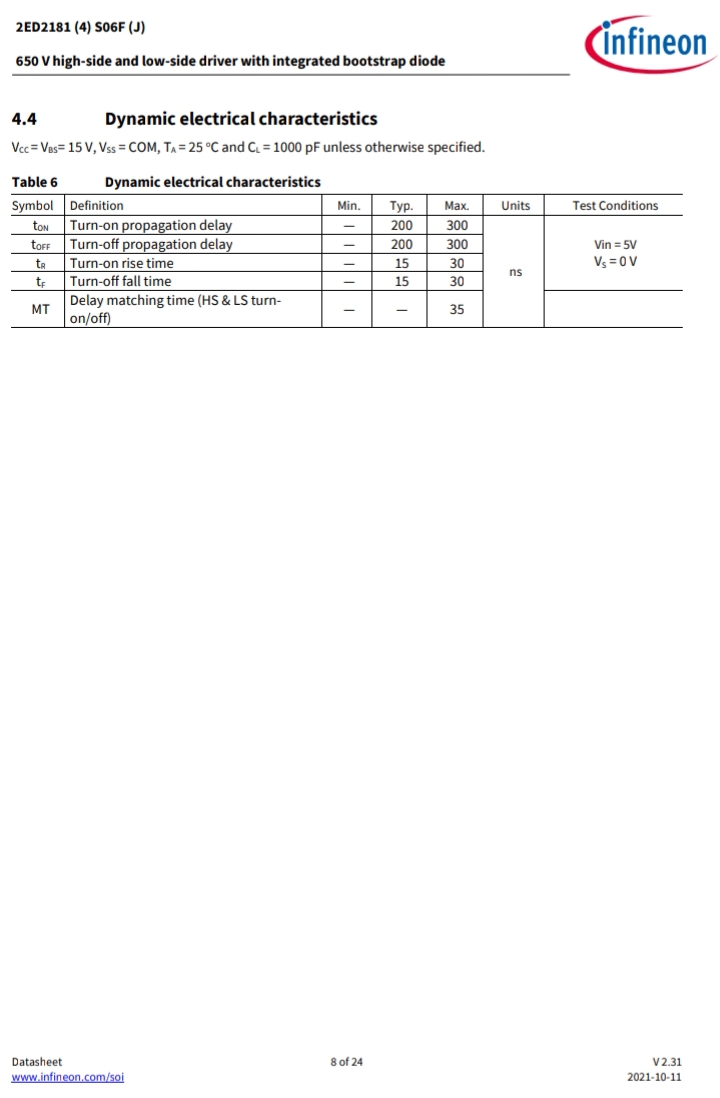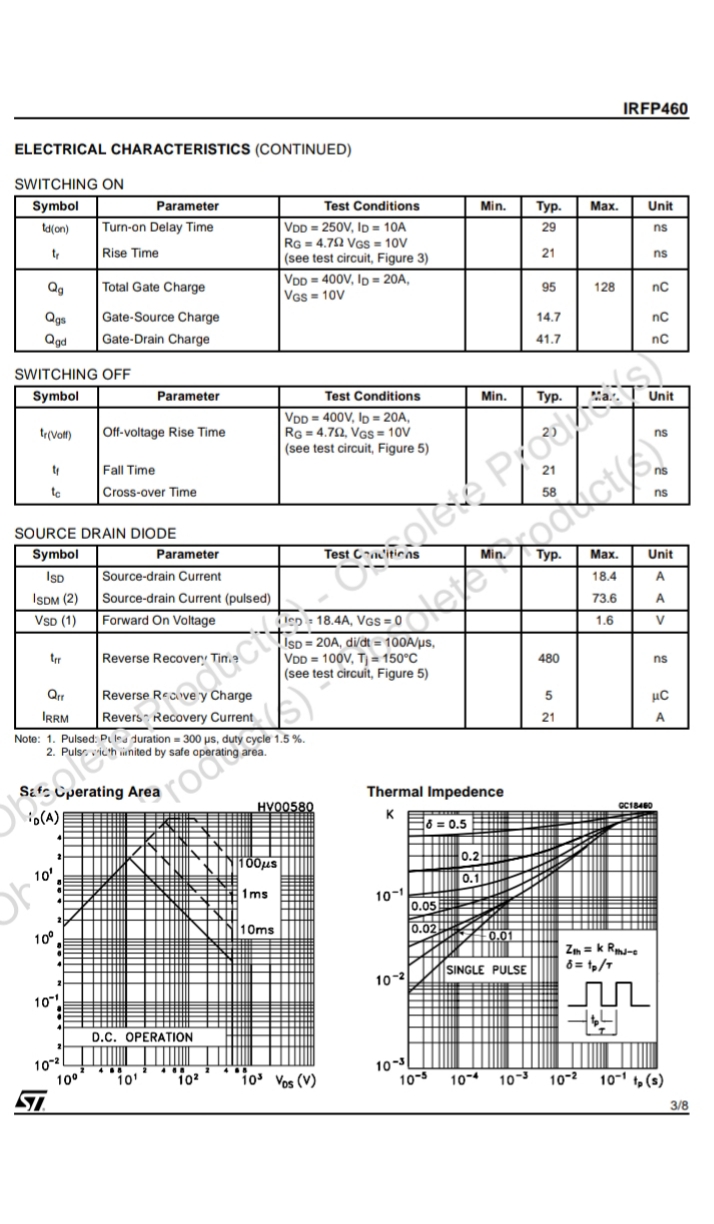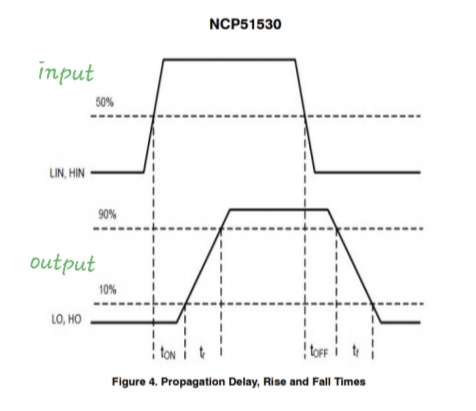Post History
Hi guys so recently i was looking for a mosfet and a gate drivers and between a lot of their specification the rise/fall time and Turn-On/off Delay Time sometime it called propagation. My question...
#4: Post edited
- Hi guys so recently i was looking for a mosfet and a gate drivers and between a lot of their specification the rise/fall time and Turn-On/off Delay Time sometime it called propagation.
- My questions is what is the difference between them? And how does this affect the signals or just the switching?and my last question what is the perfect proportion between them should they be the same maybe?
- Thank you.
- **Edit:**
- Some explanation is needed here, so to drive a mosfet we need a PWM source and a gate driver in case if the potential source is low or if we are driving multiple mosfets like in case of H-bridge. Now the complexity begins when we try to put all that together **"Synchronisation"** so we have to choose well and specially when we deal with a high frequencies and to do that we need to have a good understanding of some timing specs.
- Here an example of some specs of mosfets and gate drivers:
- 
- 

- Hi guys so recently i was looking for a mosfet and a gate drivers and between a lot of their specification the rise/fall time and Turn-On/off Delay Time sometime it called propagation.
- My questions is what is the difference between them? And how does this affect the signals or just the switching?and my last question what is the perfect proportion between them should they be the same maybe?
- Thank you.
- **Edit:**
- Some explanation is needed here, so to drive a mosfet we need a PWM source and a gate driver in case if the potential source is low or if we are driving multiple mosfets like in case of H-bridge. Now the complexity begins when we try to put all that together **"Synchronisation"** so we have to choose well and specially when we deal with a high frequencies and to do that we need to have a good understanding of some timing specs.
- Here an example of some specs of mosfets and gate drivers:
- 
- 
- 
- **Edit 2:**
- " In general, the on/off delay is how long it takes from changing the input until the output starts to do something. "
- Very clear so the ON/OFF DELAY its the time that the FET driver or the mosfet take to replicate the input signal and the RISE/FALL time is the time that it take to change from the ON state to the OFF state and vice versa.
- 
- That drive me to ask another question,
- It's okay that the input and the output have a delay ON/OFF time as long as the ON is equal to the OFF time, but what happen if they are not equal?
- Another question about the RISE/FALL time, which is the more important as Mr. Olin mentioned in his answer, the lower it take the better, less power losses and heat to disipitate. So the RISE/FALL time should be identical to the input and must not be higher, but what happens if it is lower than the input? For example the RISE/FALL time of the input is 15ns/15ns respectivly and the output can be 10ns/10ns in the datasheet.
#3: Post edited
Hi guys so recently i was looking for a mosfet and a mosfet drivers and between a lot of their specification the rise/fall time and Turn-On/off Delay Time sometime it called propagation.- My questions is what is the difference between them? And how does this affect the signals or just the switching?and my last question what is the perfect proportion between them should they be the same maybe?
- Thank you.
- **Edit:**
Some explanation is needed here, so to drive a mosfet we need a PWM source and a mosfet driver in case if the potential source is low or if we are driving multiple mosfets like in case of H-bridge. Now the complexity begins when you try to put all that together **"Synchronisation"** so we have to choose well and specially when we deal with a high frequencies and to do that we need to have a good understanding of some timing specs.Here an example of some specs of mosfets and mosfet drivers:- 
- 
- Hi guys so recently i was looking for a mosfet and a gate drivers and between a lot of their specification the rise/fall time and Turn-On/off Delay Time sometime it called propagation.
- My questions is what is the difference between them? And how does this affect the signals or just the switching?and my last question what is the perfect proportion between them should they be the same maybe?
- Thank you.
- **Edit:**
- Some explanation is needed here, so to drive a mosfet we need a PWM source and a gate driver in case if the potential source is low or if we are driving multiple mosfets like in case of H-bridge. Now the complexity begins when we try to put all that together **"Synchronisation"** so we have to choose well and specially when we deal with a high frequencies and to do that we need to have a good understanding of some timing specs.
- Here an example of some specs of mosfets and gate drivers:
- 
- 
- 
#2: Post edited
- Hi guys so recently i was looking for a mosfet and a mosfet drivers and between a lot of their specification the rise/fall time and Turn-On/off Delay Time sometime it called propagation.
- My questions is what is the difference between them? And how does this affect the signals or just the switching?and my last question what is the perfect proportion between them should they be the same maybe?
Thank you.
- Hi guys so recently i was looking for a mosfet and a mosfet drivers and between a lot of their specification the rise/fall time and Turn-On/off Delay Time sometime it called propagation.
- My questions is what is the difference between them? And how does this affect the signals or just the switching?and my last question what is the perfect proportion between them should they be the same maybe?
- Thank you.
- **Edit:**
- Some explanation is needed here, so to drive a mosfet we need a PWM source and a mosfet driver in case if the potential source is low or if we are driving multiple mosfets like in case of H-bridge. Now the complexity begins when you try to put all that together **"Synchronisation"** so we have to choose well and specially when we deal with a high frequencies and to do that we need to have a good understanding of some timing specs.
- Here an example of some specs of mosfets and mosfet drivers:
- 
- 
- 
#1: Initial revision
What is the difference between rise/fall time and Turn-On/off Delay Time?
Hi guys so recently i was looking for a mosfet and a mosfet drivers and between a lot of their specification the rise/fall time and Turn-On/off Delay Time sometime it called propagation. My questions is what is the difference between them? And how does this affect the signals or just the switching?and my last question what is the perfect proportion between them should they be the same maybe? Thank you.


















